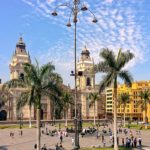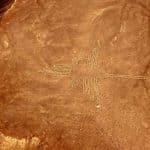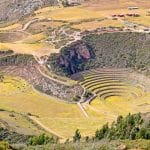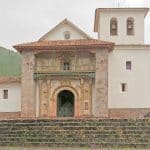In this post you will find all the information about Arequipa that you will need for your next trip: the location, history, elevation, climate, tourist sites, and a lot more about Arequipa.
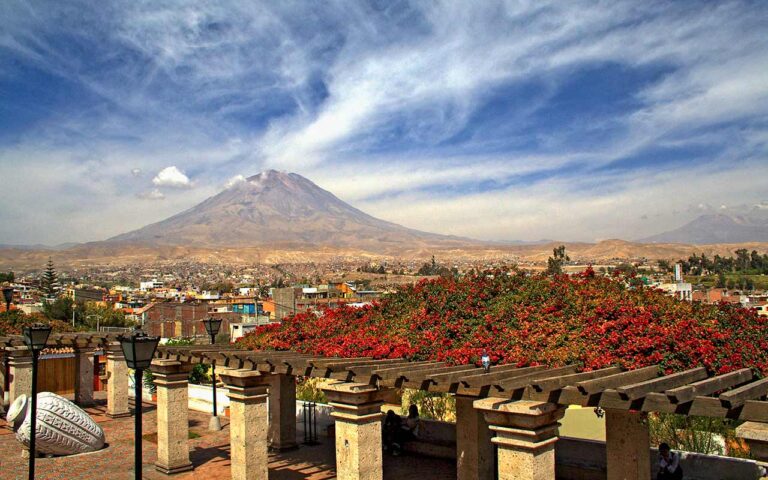
So, without beating around the bush, let’s explore this important tourist destination known all over the world for the Colca Canyon, the Misti Volcano, the Convent of Santa Catalina, and for the white stone volcanic blocks called sillar which were used in the construction of the principle monuments of the city.
The Meaning of Arequipa
There are several versions of the story about how Arequipa got its name. The first version explains that the derivation of the city’s name comes from two Quechua words, Ari and Qepay. In English, ari means ‘yes’, and qepay means ‘stay’. So, Arequipa would mean: ‘Yes, stay.’ In the second version, the Chroniclers state that in the Aymara language, Ari means ‘summit’ and Queppa means ‘behind’. Thus, the two words together would signify: City between the summits or City behind the mountains. In the third version, Fr. Blas Valera theorizes that the name means’ sound the trumpet’, and it comes from the word, Qepan, which is the name of the giant conch shell which, for thousands of years, has been used as a trumpet in Peru. It is still used as such in the present day.
General Information about Arequipa
- Capital: The city of Arequipa.
- Area: 6,334,539 sq. km.
- Population: 1,382,730.
- Elevation: between 2300 and 2400 masl.
- Telephone prefix: 054.
- Spanish name by which the people who hail from this area are called: Arequipeño for a male, and Arequipeña for a female.
- Names and titles for the city: The White City, the Legal Capital of Peru, Cultural Heritage of Humanity.
The Location of Arequipa
The Arequipa region is located in southern Peru, near the Nazca Lines and Lake Titicaca. It is not located exactly in the mountains or on the coast, but it is situated between the mountains and the coast. This is privileged location. Arequipa is said to have a better location than many other regions of Peru.
Its exact geographical coordinates are:
- Latitude: -16.3988895
- Longitude: -71.5350037
This beautiful region is bordered on the north by the Ayacucho, Apurímac, and Cusco regions; on the east by the Puno region; on the southeast by the Moquegua region; on the northeast by the Ica region; and to the west is the Pacific Ocean.
History
The origins of Arequipa date back to the early Churajon, Chuquibamba and Wari civilizations. The great Incan civilization settled and farmed in the fertile valleys of Arequipa. But it was during the colonial period, on August 15, 1540, that the city was actually founded in the name of Villa Hermosa de Nuestra Señora de la Asunta (Beautiful Town of Our Lady of the Assumption). Ever since September 22, 1541, the city has been known as Arequipa.
Actually, Arequipa is one the most populous cities in Peru, and it is also a main tourist destination which is noted for its impressive pre-Columbian monuments, and for its outstanding architecture. During the colonial era, the churches with their facades and vaults, along with the old mansions, monasteries, and convents, were all built in the Barroque style using white volcanic sillar stone.
Did you know that the people from Arequipa are the proudest people in Peru? Within the heart of every person from Arequipa there is rebellious spirit, somewhat confrontational and anti-centralist. A person from Arequipa would never consider himself to be provincial. Instead, he would consider himself to be a citizen of the People’s Republic of Arequipa.
How to get to Arequipa
The region of Arequipa is located in an easily accessible area. So getting to Arequipa is not at all difficult.
Let’s see what the main ways of getting to Arequipa are.
By Air
One easy way of getting to Arequipa is to take a domestic flight from Lima or from Cusco; or by taking a seasonal flight from Santiago, Chile, or from La Paz, Bolivia.
The principle airlines which offer daily service to Arequipa are: Latam, Avianca, Sky Airlines and Peruvian Airlines. Of these, it is Latam which offers the most flights every day, with 10 direct flights arriving from Lima, and one flight from Cusco.
The flight time from Lima is 90 minutes, while from Cusco the flight time is 40 minutes.
By Land
These days it is possible to find overland transportation to Arequipa from almost every corner of Peru. You can even get to Arequipa from Brazil, Chile, and Bolivia. Nevertheless, if you are traveling to the Arequipa region by land, you should consider the following routes: the Lima – Nazca – Arequipa route; the Cusco – Puno – Arequipa route; the Cusco – Espinar – Arequipa route; the Puerto Maldonado – Puno – Arequipa route; and the Tacna – Ilo – Arequipa route.
Elevation
The city of Arequipa is located at an elevation of 2335 masl. The exact altitude varies according to which part of the city you are in.
Distance
Here are the distances in kilometers and the travel times to Arequipa from Peru’s main cities, every one of which has bus service to Arequipa:
- Lima – Arequipa: 1013 km. 17 hours.
- Puno – Arequipa. 297 km. 6 hours and 30 minutes .
- Juliaca – Arequipa: 270 km. 6 hours.
- Cusco – Arequipa, vía Espinar: 510 km. 11 hours.
- Tacna Arequipa: 370 km. 6 hours.
- Nazca – Arequipa: 570 km. 12 hours.
- Puerto Maldonado. 832 km vía Juliaca. 16 hours and 30 minutes.
- La Paz (Bolivia) – Arequipa: 565 km. 12 hours.
- Santiago de Chile – Arequipa. 2465 km. 30 hours.
- Rio de Janeiro (Brasil) – Arequipa, by Bolivia. 3870 km. 62 hours.
On the other hand, here are the distances and the approximate travel times from the city of Arequipa to the main cities within the province of Arequipa:
- Camaná: 173 km. 2 hours and 30 minutes.
- Caravelí: 382 km. 7 hours.
- Aplao: 178 km. 3 hours.
- Chivay, Valle del Colca: 162 km. 4 hours.
- Chuquibamba: 234 km. 5 hours.
- Mollendo: 113 km. 2 hours y 30 minutes.
- Cotahuasi: 379 km. 12 hours.
Climate
Throughout the year, the temperature in Arequipa usually stays between 9 °C and 23 °C. Only on rare occasions does the temperature exceed 25 °C or drop below 7 °C. There are a lot of people that say Arequipa has the finest climate in southern Peru.
However, like most places in Peru, there are 2 distinct seasons.
- A short, dry, partly cloudy, and very comfortable summer from mid-December until the end of March.
- A longer dry, cloudy, and cool winter from April through November.
Tourist sites
Arequipa has lots of marvelous cultural destinations and natural wonders that make it an ideal place to visit.
Among the most frequently visited sites, the following ones stand out: the Santa Catalina Monastery, the Colca Valley, the Cross of the Condor Lookout Point, and the Cotahuasi Canyon. There are also others which you will find on the list below:
- Main Square of Arequipa.
- Church and Company Complex.
- Arequipa Cathedral
- Santa Catalina Monastery
- Beautiful Villa of Yanahuara (Yanahuara Viewpoint).
- The Founder’s Mansion.
- Andean Sanctuaries Museum.
- Sabandia Mill.
- Moral House.
- San Lázaro neighborhood.
- Villa of Cayma.
- Beach of the French Caleta and Ancumpita.
- Misti volcano.
- Yura thermal baths.
- Sumbay Caves – Rock Art (Arequipa).
- Aguada Blanca National Reserve.
- Colca Canyon.
- Cotahuasi National Reserve.
- Chacapi Hot Springs.
- Thermal baths of Calera Chivay.
- Añashuayco quarries.
To learn more about the beauty of the monuments, the snow-capped peaks, the volcanoes, and the canyons of the Arequipa region, we invite you to visit our post: The Main Tourist Sites of Arequipa.
The Tourist Calendar of Arequipa
Another reason to visit Arequipa is to appreciate its great cultural legacy which is still present in the living culture of its villages, especially on the days of their main festivities.
The principle fiestas in Arequipa feature rejoicing, joy, fun, customs, and traditions. Here are the dates to keep in mind:
- January 6: Descent of the Kings and Shaking Perales.
- January 20: Feast of the Lord of the Judgment.
- February 14: Feast of the Virgen del Buen Paso, in Caravelí.
- February, month of the carnivals that begins on February 26 and lasts a week.
- March: Holy Week.
- May 1: Feast and pilgrimage to the Sanctuary of the Virgen de Chapi, in the district of Polobaya.
- May 11 to 15: Feast of San Isidro Labrador, in most provinces of Arequipa.
- June 21: Anniversary of the province of Chivay, in the Colca Valley.
- June 24: Feast of San Juan Bautista, in the Yanahura district.
- July 27: Feast of the Virgin of Perpetual Help, in the province of Tiabaya.
- July 24: Bullfight, in the Characato District.
- July 14 to 17: Feast of the Virgen del Carmen.
- 1st week of August: Procession of the Pass, in the city of Arequipa.
- 1st week of August: T’inka of cattle and cleaning of ditches, in the Colca Valley.
- August 8: Feast of the Lord of the Cane.
- August 15: Anniversary of the city of Arequipa and Tourist Week.
- August 15: Feast of the Virgen de la Asunta.
- September 8: Feast of the Virgen de las Peñas, in the province of Castilla.
- October 21: Festivity of Santa Úrsula.
- November 1: Feast of the Gua-Guas and Marzipan for the Day of Saints.
- November 2: Bone procession for the Day of the Dead, Cayma district.
- December 8: Feast of the Immaculate Conception, in most provinces of Arequipa.
Arequipeñan Cuisine
You don’t have to take our word for it. Both CNN and National Geographic have done reports on Arequipeñan cuisine. The gist of their reporting was that the gastronomical tradition of Arequipa produces some of the finest food in Peru, and in all of South America. The dishes here are noted for their wide variety of flavors and textures.
Speaking in numbers, in the Arequipa region there are 194 typical, traditional dishes which are distinguished by their high quality, their variety of flavors, their elaborate preparation, the exquisiteness of their sauces, and the wonderful combination of Andean products which are used to make each one.
Another element of Arequipeñan gastronomic tradition is the preparation of different dishes for each day of the week. On Monday, they prepare Chaque; on Tuesday, Chairo; on Wednesday, Chochaca; on Thursday, Menestron; on Friday, Chupe; on Saturday, Timpusca; and on Sunday, they make either Pebre or Caldo Blanco (White Soup).
The Principle Traditional Dishes of Arequipa
- Ocopa Arequipeña. This is a sauce which is noted for its texture, its color, and its spicy flavor. It is served with boiled potatoes, hard-boiled eggs, and olives.
- Rocoto Relleno (Stuffed Pepper). This dish originated in Arequipa. It is prepared with diced beef, chopped onion, ground red pepper, roast peanuts, hard-boiled egg cut in slices, cheese, and milk. It is served with potato casserole, baked potato, mashed potato, or rice.
- Cauchi or Cauche. This is a soup prepared with cheese, lima beans, onion, tomato, chili, and huacatay which is an Andean herb. This plate is cooked during the rainy season.
- Solterito arequipeño. This is a consistantly delicious dish cooked with a base of corn-on-the-cob, green lima beans, onion, tomato, olives, and cheese. It is prepared during carnival season, in February and March.
- Chupe de camarones ( Shrimp Soup). This is delectable dish with a lot of history, color, and a great taste. It is prepared with shrimp, milk, eggs, and oregano.
- Cuy chactado. This is a very famous dish from Arequipa that can usually be found in restaurants and local picanterías. It consists of a fried cuy (guinea pig) and is served with potatoes and Ocopa Arequipeña.
- Chairo. This is a soup which is served during carnival and on cold days. It is a very nutritious dish prepared with products native to the high Andes.
- Arequipa-style Adobo. This is a typical dish that seduces even the most demanding palates with its intense color and pleasant, spicy taste. It is prepared with pork loin, ground pepper, ground garlic, red onion, red vinegar, red pepper, purple corn drink, oregano, rosemary, and cumin.
- Pebre. This is a very popular soup which is made with lamb or chicken, beef jerky, potato, cassava, freeze-dried potato, garbanzo beans, pepper, garlic, and onion.
Tourism in Arequipa
Currently, tourism has become one of the main pillars of the economy of the region. After mining and agriculture, it is the principle economic activity in the area.
Tourist Activities
In Arequipa there are lots of different tourist activities available. This region is full of magnificent archeological monuments and amazing natural attractions. Arequipa has a wonderful cultural legacy. However, the most popular activities that the majority of tourists prefer are as follows:
- Participating in Adventure Sports. trekking, river rafting, and mountain biking.
- Visiting Archeological Sites Santa Catalina Monastery, the Yanahuara Scenic Overlook, and Arequipa’s Central Historical District.
- Observing the Natural Wonders and the Incredible Variety of the Flora and Fauna.
Lodging in Arequipa
The hotels and the lodging establishments in Arequipa have all the comforts that you would expect to find in a big city. Therefore, you can enjoy a pleasant and comfortable stay. Every kind of hotel is available, from the basic hotel up to the 5-star luxury hotel, and they are open 365 days a year.
Here is a list of the most highly recommended hotels in Arequipa:
- Wyndham Costa del Sol Arequipa
- Casa Andina Premium Arequipa.
- Cirqa Hotel.
- Sonesta Hotel Arequipa.
- Katari Hotel Plaza de Armas.
- Casona Plaza Hotel Arequipa.
- Hotel Estelar Lago.
- San Agustín Posada del Monasterio
- Tierra Viva Arequipa Plaza.
Restaurants
In order to enjoy the flavors, textures, and colors of the world-famous cuisine of Arequipa, you will find innumerable tourist restaurants.
- Zigzag.
- Alma Bar Restaurante.
- Casta Fior.
- Chicha por Gaston Acurio.
- La Trattoria del Monasterio.
- Arthur Restaurant.
- La Nueva Palomino.
- Salamanto Restaurant.
- E-cousine.
Hospitals and Clínics
Like all the major cities of Peru, Arequipa has plenty of hospitals, clinics, health centers, and pharmacies. So in case you are in need of medical attention, it will be easy to find.
- Carlos Alberto Seguin Escobedo National Hospital.
- General Hospital Honorio Delgado Espinoza.
- Goyeneche hospital.
- Clínica Arequipa – Medical clinic.
- Vallesur Clinic – Medical clinic.
- Monte Carmelo Medical Center – Local medical services.
- San Juan de Dios Arequipa Clinical Home.
- Sanna clinics.
Traditional Handicraft Markets
The local markets of the White City are full of bright colors, a variety of fine products, and the cheerful voices of merchants as they encourage you to visit their booth and check out their wares. A market is also a great place to learn more about local customs and traditions.
Some of the markets that you can visit and where you can learn more about local culture are:
- San Camilo Market, the oldest in Arequipa.
- Market of the Antiquilla.
- Yanahuara handicraft market.
- San Antonio market.
- Fundo El Fierro craft market.
Shopping Centers
You will also find lots of shopping centers in the White City. They offer a wide variety of entertainment products and services. So visiting these malls with your family, friends, or colleagues is bound to be a pleasant experience.
- Mall Plaza de Arequipa.
- Real Plaza de Arequipa.
- Porongoche Adventure Mall.
- Arequipa Center
- Lambramani Park
Banks, ATM’s, and Shops Where You Can Change Money
Finally, you will not have any problems dealing with money in Arequipa. Within the Central Historical District you will find plenty of banks, ATM’s, and money changing shops. They are there to help you carry out whatever transaction you might want to make.
- Credit Bank of Peru
- Continental Bank.
- Interbank
- Banbif Arequipa.
- Bank of the Nation Arequipa.
- Azteca Bank.
- Scotiabank
- Ripley Bank.
- Falabella Bank.
On your trip to Peru, don’t miss Arequipa. It is a magical destination where you find ancient cultural traditions, delicious food, incredible volcanoes, deep canyons, imposing archeological sites, fertile valleys, a beautiful countryside, and friendly people.
Come to the land of the ‘characatos’ and explore the natural wonders and the cultural traditions of Arequipa.
